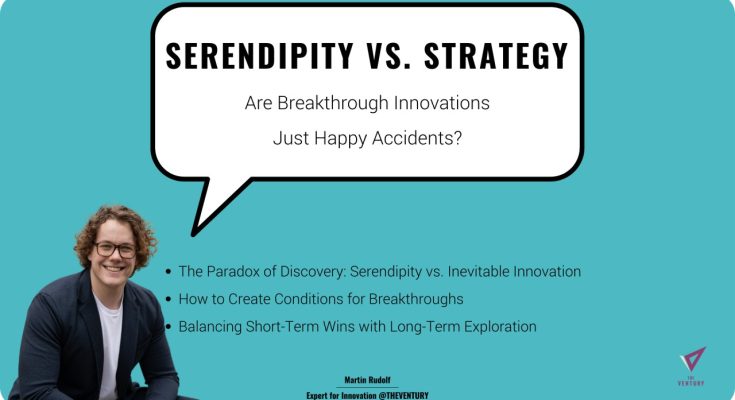Innovation is often portrayed as a deliberate process—one driven by strategy, research, and rigorous planning. While these elements are undeniably important, they don’t tell the whole story. Some of the most transformative breakthroughs have emerged not from structured efforts, but from unexpected encounters, accidental discoveries, and moments of insight that couldn’t have been engineered. This is the realm of serendipity, a force that defies predictability yet plays a crucial role in shaping the future of business and technology. When embraced rather than dismissed, serendipity becomes a powerful catalyst for innovation.
The nature of serendipity lies in its unpredictability. It’s the chance meeting that sparks a new idea, the misstep that reveals a better path, or the unrelated observation that suddenly connects dots in a novel way. These moments often occur outside the confines of formal planning. They arise when people are exploring, experimenting, or simply paying attention. Alexander Fleming didn’t set out to discover penicillin—he noticed something unusual in a petri dish and followed his curiosity. That simple act of observation led to one of the most significant medical breakthroughs of the twentieth century. Serendipity doesn’t replace intentionality, but it complements it by opening doors that intention alone might miss.
In business, serendipity often shows up in conversations. A casual remark from a colleague, a question from a customer, or an unexpected comment during a meeting can trigger a new line of thinking. These interactions are rarely part of a formal agenda, yet they can lead to profound insights. Companies that foster open dialogue and cross-functional collaboration create fertile ground for serendipitous moments. When people from different backgrounds and disciplines interact, they bring diverse perspectives that can collide in surprising and productive ways. Innovation thrives not just in labs and strategy sessions, but in hallways, coffee breaks, and shared spaces where ideas flow freely.
The environment plays a significant role in enabling serendipity. Organizations that encourage exploration, tolerate ambiguity, and reward curiosity are more likely to benefit from unexpected discoveries. This means creating space for experimentation, allowing time for reflection, and resisting the urge to over-engineer every process. Google’s early “20 percent time” policy, which allowed employees to pursue side projects, led to products like Gmail and AdSense—ideas that might never have surfaced through traditional planning. By giving people room to wander intellectually, businesses increase the chances of stumbling upon something valuable.
Technology has added a new dimension to serendipity. Algorithms and data-driven systems are designed to optimize and predict, but they can also surface unexpected connections. Recommendation engines, for example, sometimes introduce users to ideas or products they wouldn’t have found on their own. Social media platforms, despite their flaws, can facilitate chance encounters with content or people that spark new thinking. The challenge is to balance efficiency with exploration—to design systems that don’t just reinforce existing preferences, but occasionally surprise and provoke. Serendipity in the digital age requires intentional design that leaves room for the unplanned.
Leadership plays a pivotal role in how serendipity is perceived and leveraged. Leaders who value curiosity and remain open to unexpected input create cultures where innovation can flourish. This means listening actively, encouraging experimentation, and being willing to pivot when new insights emerge. It also means recognizing that not every valuable idea comes from a formal process. Some of the most impactful innovations begin as side notes, tangents, or anomalies. A leader who can spot these moments and nurture them is more likely to guide their organization toward meaningful breakthroughs.
Serendipity also requires a mindset of receptivity. It’s not enough for opportunities to arise—they must be recognized and acted upon. This demands attentiveness, humility, and a willingness to explore paths that weren’t part of the original plan. Innovators often describe moments when something unexpected caught their attention and led them in a new direction. These stories highlight the importance of being mentally flexible and emotionally open. Serendipity favors those who are curious, observant, and willing to follow threads that others might ignore.
While serendipity cannot be forced, it can be invited. Businesses can design environments, cultures, and systems that increase the likelihood of unexpected insights. This involves creating diverse teams, encouraging interdisciplinary thinking, and allowing time for exploration. It also means celebrating curiosity and recognizing that not all value can be measured immediately. Some ideas take time to mature, and some connections only reveal their significance in hindsight. By valuing the process as much as the outcome, organizations can cultivate a more serendipity-friendly approach to innovation.
Ultimately, the role of serendipity in innovation is to remind us that not everything worth discovering can be planned. It challenges the notion that progress is linear and controlled, offering instead a vision of creativity that is dynamic, relational, and often surprising. When businesses learn to embrace the unexpected—not as a disruption, but as a source of possibility—they unlock new dimensions of growth and transformation. Serendipity may be unpredictable, but its impact is undeniable. And in a world that prizes agility and originality, learning to welcome the unplanned might be one of the most strategic moves a company can make.



